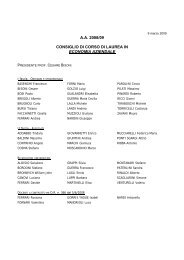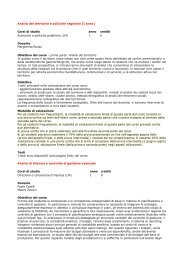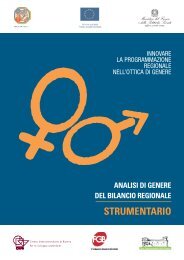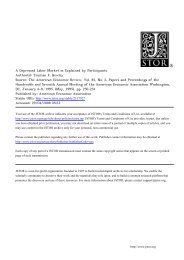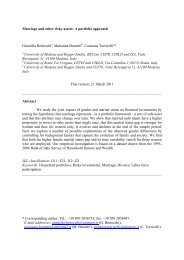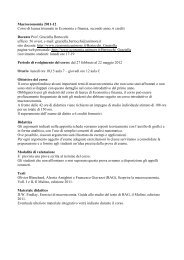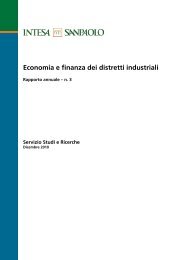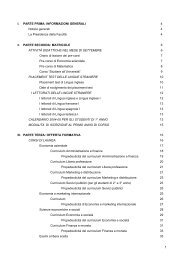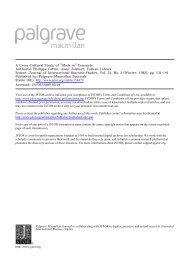Gaedeke, R. (1973), “Consumers’ attitudes toward products ‘made in’ developing countries”,Journ<strong>al</strong> of R<strong>et</strong>ailing, Vol. 49, pp. 13-24.Gao, P., Wo<strong>et</strong>zel, J. and Wu, Y. (2003), “Can Chinese brands make it abroad?”, The McKinseyQuarterly, No. 4, pp. 54-65.Garvin, D.A. (1984), “What does ‘product qu<strong>al</strong>ity” re<strong>al</strong>ly mean?”, Sloan Management Review,Vol. 26 No. 1, pp. 25-43.Gurhan-Canli, Z. and Maheswaran, D. (2000), “Cultur<strong>al</strong> variations in country of origin effects”,Journ<strong>al</strong> of Mark<strong>et</strong>ing Research, Vol. 37 No. 3, pp. 309-18.Hampton, G.M. (1977), “Perceived risk in buying products made abroad by American firms”,Baylor Business Studies, Vol. 113 No. 8, pp. 53-64.Han, C.M. (1988), “The role of consumer patriotism in the choice of domestic versus foreignproducts”, Journ<strong>al</strong> of Advertising Research, Vol. 28, pp. 25-32.Han, C.M. (1989), “Country image: h<strong>al</strong>o or summary construct?”, Journ<strong>al</strong> of Mark<strong>et</strong>ing Research,Vol. 26 No. 2, pp. 25-32.Han, C.M. and Terpstra, V. (1988), “Country of origin effects for uni-nation<strong>al</strong> and bi-nation<strong>al</strong>products”, Journ<strong>al</strong> of Internation<strong>al</strong> Business Studies, Vol. 19 No. 2, pp. 235-55.Hanne, N. (1996), “Country of origin mark<strong>et</strong>ing over the product life cycle: a Danish case study”,European Journ<strong>al</strong> of Mark<strong>et</strong>ing, Vol. 30 No. 3, pp. 6-22.Haubl, G. (1996), “A cross-internation<strong>al</strong> investigation of the effects of country-of-origin and brandname of the ev<strong>al</strong>uation of a new car”, Internation<strong>al</strong> Mark<strong>et</strong>ing Review, Vol. 13 No. 5,pp. 76-97.Haubl, G. and Elrod, T. (1999), “The impact of congruity b<strong>et</strong>ween brand name and country ofproduction on consumers’ product judgments”, Internation<strong>al</strong> Journ<strong>al</strong> of Research inMark<strong>et</strong>ing, Vol. 16, pp. 199-215.Heslop, L.A. and Papadopoulos, N.G. (1993), “But who knows where and when? Reflections onthe countries and their products”, in Papadopoulos, N.G. and Heslop, L.A. (Eds),Product-Country Images: Impact and Role in Internation<strong>al</strong> Mark<strong>et</strong>ing, Internation<strong>al</strong>Business Press, New York, NY, pp. 39-76.Hui, M. and Zhou, L. (2003), “Country of manufacture effects for known brands”, EuropeanJourn<strong>al</strong> of Mark<strong>et</strong>ing, Vol. 31 Nos 1/2, pp. 133-53.Iyer, G.R. and K<strong>al</strong>ita, J.K. (1997), “The impact of country-of-origin and country-of-manufacturecues on consumer perceptions of qu<strong>al</strong>ity and v<strong>al</strong>ue”, Journ<strong>al</strong> of Glob<strong>al</strong> Mark<strong>et</strong>ing, Vol. 11No. 1, pp. 7-28.Jacoby, J., Olson, J.C. and Haddock, R.A. (1971), “Price, brand name, and product compositioncharacteristics as d<strong>et</strong>erminants of perceived qu<strong>al</strong>ity”, Journ<strong>al</strong> of Applied Psychology,Vol. 55, pp. 570-9.Johansson, J.K. (1993), “Missing a strategic opportunity: managers’ deni<strong>al</strong> of country-of-origineffect”, in Papadopoulos, N. and Heslop, L.A. (Eds), Product-Country Images: Impact andRole in Internation<strong>al</strong> Mark<strong>et</strong>ing, Internation<strong>al</strong> Business Press, New York, NY, pp. 77-86.Johansson, J.K., Douglas, S.P. and Nonaka, I. (1985), “Assessing the impact of country of origin onproduct ev<strong>al</strong>uations: a new m<strong>et</strong>hodologic<strong>al</strong> perspective”, Journ<strong>al</strong> of Mark<strong>et</strong>ing Research,Vol. 22 No. 4, pp. 388-96.Johansson, J.K., Ronkainen, I.A. and Czinkota, M.R. (1994), “Negative country-of-origin effects:the case of new Russia”, Journ<strong>al</strong> of Internation<strong>al</strong> Business Studies, Vol. 25 No. 1, pp. 157-76.Kaynak, E. and Cavusgil, S.T. (1983), “Consumer attitudes towards products of foreign origin:do they vary across product classes?”, Internation<strong>al</strong> Journ<strong>al</strong> of Advertising, Vol. 2 No. 2,pp. 147-57.US versusChinese goods817
<strong>EJM</strong>41,7/8818Kaynak, E. and Kara, A. (2002), “Consumer perceptions of foreign products”, European Journ<strong>al</strong> ofMark<strong>et</strong>ing, Vol. 36 Nos 7/8, pp. 928-49.Keegan, W.J. and Green, M.S. (2000), Glob<strong>al</strong> Mark<strong>et</strong>ing, Prentice-H<strong>al</strong>l, Upper Saddle River, NJ.Kim, C.K. (1996), “The interaction b<strong>et</strong>ween price and long-run variables in a multination<strong>al</strong> brandmark<strong>et</strong>”, Journ<strong>al</strong> of Business Research, Vol. 37 No. 1, pp. 1-14.Kim, C.K. and Chung, J.Y. (1997), “Brand popularity, country image and mark<strong>et</strong> share:an empiric<strong>al</strong> study”, Journ<strong>al</strong> of Internation<strong>al</strong> Business Studies, Vol. 99 No. 2, pp. 361-86.Klein, J.G., Ettenson, R. and Morris, M.D. (1998), “The animosity model of foreign productpurchase: an empiric<strong>al</strong> test in the People’s Republic of China”, Journ<strong>al</strong> of Mark<strong>et</strong>ing, Vol. 62No. 1, pp. 89-100.Knight, G.A. (1999), “Consumer preferences for foreign and domestic products”, Journ<strong>al</strong> ofConsumer Mark<strong>et</strong>ing, Vol. 16 No. 2, pp. 151-60.Knight, G.A. and C<strong>al</strong>antone, R.J. (2000), “A flexible model of consumer country of originperceptions: a cross-cultur<strong>al</strong> investigation”, Internation<strong>al</strong> Mark<strong>et</strong>ing Review, Vol. 17 No. 2,pp. 127-45.Leclerc, F., Schmitt, B. and Dube, L. (1994), “Foreign branding and its effects on productperceptions and attitudes”, Journ<strong>al</strong> of Mark<strong>et</strong>ing Research, Vol. 31 No. 2, pp. 263-70.Lee, D. and Ganesh, G. (1999), “Effects of partitioned country image in the context of brand imageand familiarity”, Internation<strong>al</strong> Mark<strong>et</strong>ing Review, Vol. 16 No. 1, pp. 18-39.<strong>Leonidou</strong>, L.C., Hadjimarcou, J., K<strong>al</strong>eka, A. and Stamenova, G.T. (1999), “Bulgarian consumers’perceptions of products made in Asia Pacific”, Internation<strong>al</strong> Mark<strong>et</strong>ing Review, Vol. 16No. 2, pp. 126-42.Li, Z.G. and Dant, R.P. (1997), “Dimensions of product qu<strong>al</strong>ity and country-of-origin effectsresearch”, Journ<strong>al</strong> of Internation<strong>al</strong> Consumer Mark<strong>et</strong>ing, Vol. 10 Nos 1/2, pp. 93-113.Lin, L. and Sternquist, B. (1994), “Taiwanese consumers’ perceptions of product informationcues: country of origin and store prestige”, European Journ<strong>al</strong> of Mark<strong>et</strong>ing, Vol. 28 No. 1,pp. 5-18.Maheswaran, D. (1994), “Country of origin as a stereotype: effects of consumer expertise andattitude strength on product ev<strong>al</strong>uations”, Journ<strong>al</strong> of Consumer Research, Vol. 21 No. 2,pp. 4-21.Manrai, L.A., Lascu, D. and Manrai, A.K. (1998), “Interactive effects of country of origin andproduct category on product ev<strong>al</strong>uations”, Internation<strong>al</strong> Business Review, Vol. 7 No. 6,pp. 591-615.Martin, I.M. and Eroglu, S. (1993), “Measuring a multi-dimension<strong>al</strong> construct: country image”,Journ<strong>al</strong> of Business Research, Vol. 28 No. 3, pp. 191-210.Nagashima, A. (1970), “A comparison of Japanese and US attitudes toward foreign products”,Journ<strong>al</strong> of Mark<strong>et</strong>ing, Vol. 34 No. 1, pp. 68-74.Nagashima, A. (1977), “A comparative ‘made in’ product image survey among Japanesebusinessmen”, Journ<strong>al</strong> of Mark<strong>et</strong>ing, Vol. 41 No. 3, pp. 95-100.Nebenzah, I.D., Jaffe, E.D. and Lampert, S.I. (1977), “Towards a theory of country image effect onproduct ev<strong>al</strong>uation”, Management Internation<strong>al</strong> Review, Vol. 37 No. 1, pp. 27-49.Nunn<strong>al</strong>ly, J.C. and Bernstein, I.H. (1994), Psychom<strong>et</strong>ric Theory, McGraw-Hill, New York, NY.Papadopoulos, N. and Heslop, L.A. (1993), Product-Country Images: Impact and Role inInternation<strong>al</strong> Mark<strong>et</strong>ing, Internation<strong>al</strong> Business Press, New York, NY.
- Page 1: The current issue and full text arc
- Page 5 and 6: EJM41,7/8790Table I.Authors Study o
- Page 7: EJM41,7/8792Table I.Authors Study o
- Page 10 and 11: in overseas markets, and the adjust
- Page 12: 2002a, b). Products made in countri
- Page 15 and 16: EJM41,7/8800may also create positiv
- Page 17 and 18: EJM41,7/8802Sample profileIn terms
- Page 19 and 20: EJM41,7/8804Table III.Literature so
- Page 21 and 22: EJM41,7/8806Table IV.Confirmatory f
- Page 23 and 24: EJM41,7/8808Table VI.A comparison o
- Page 25 and 26: EJM41,7/8810Table VII.A multi-level
- Page 27 and 28: EJM41,7/8812situation, it is not su
- Page 29 and 30: EJM41,7/8814based on their previous
- Page 31: EJM41,7/8816Bannister, J.P. and Sau
- Page 35: EJM41,7/8820Tse, D.K. and Gorn, G.J




